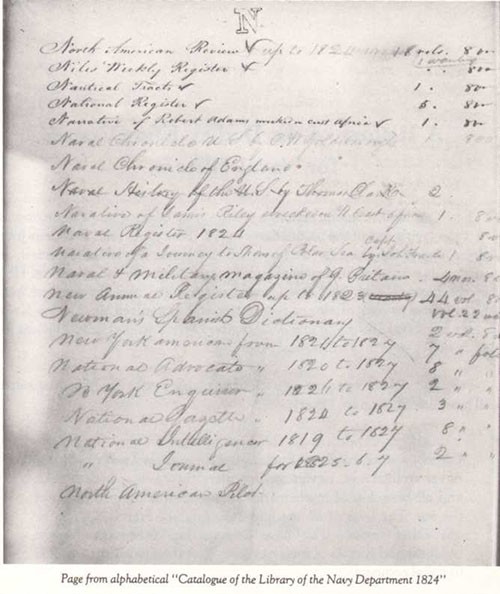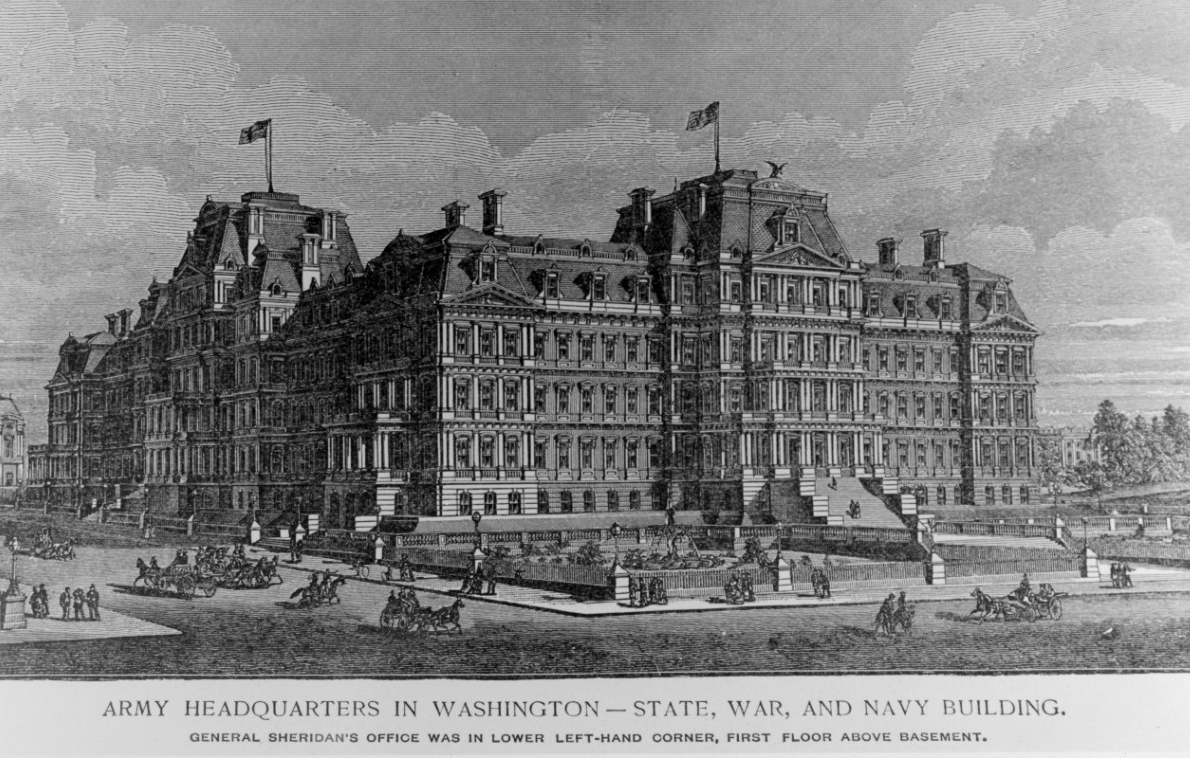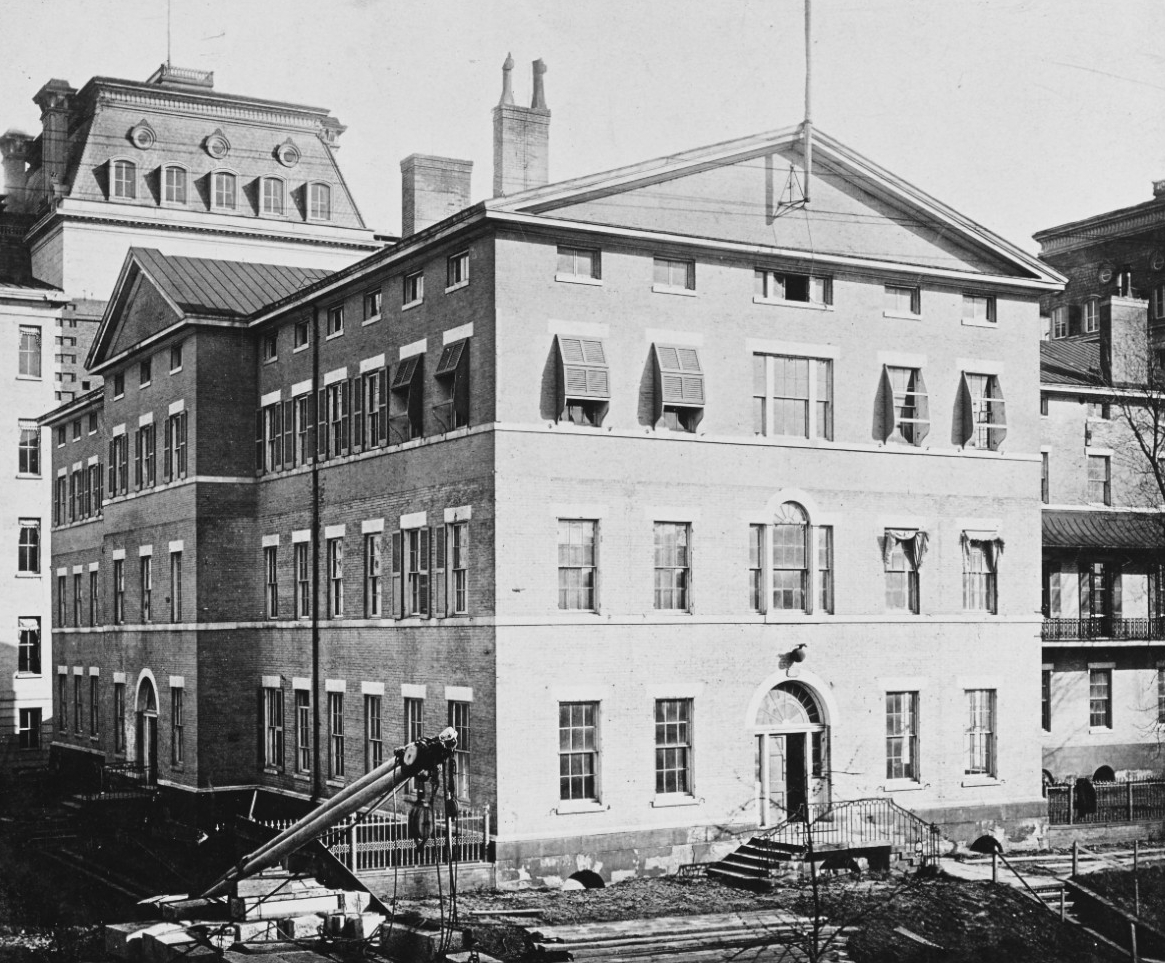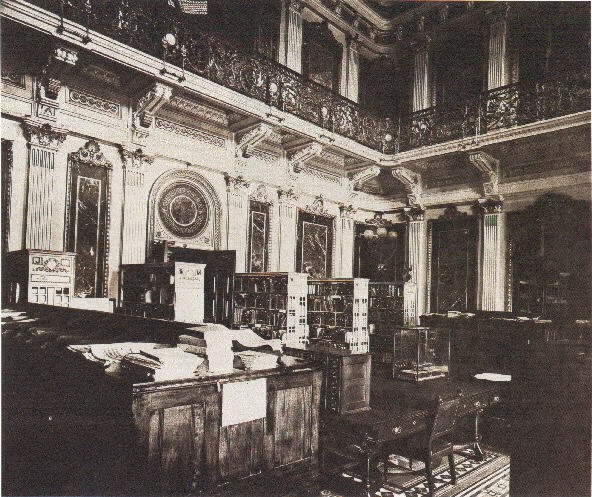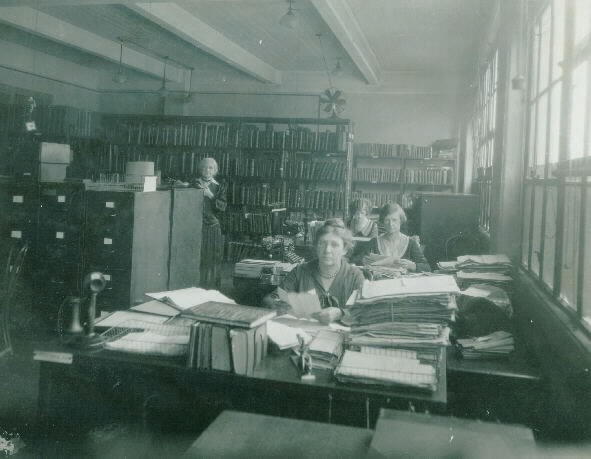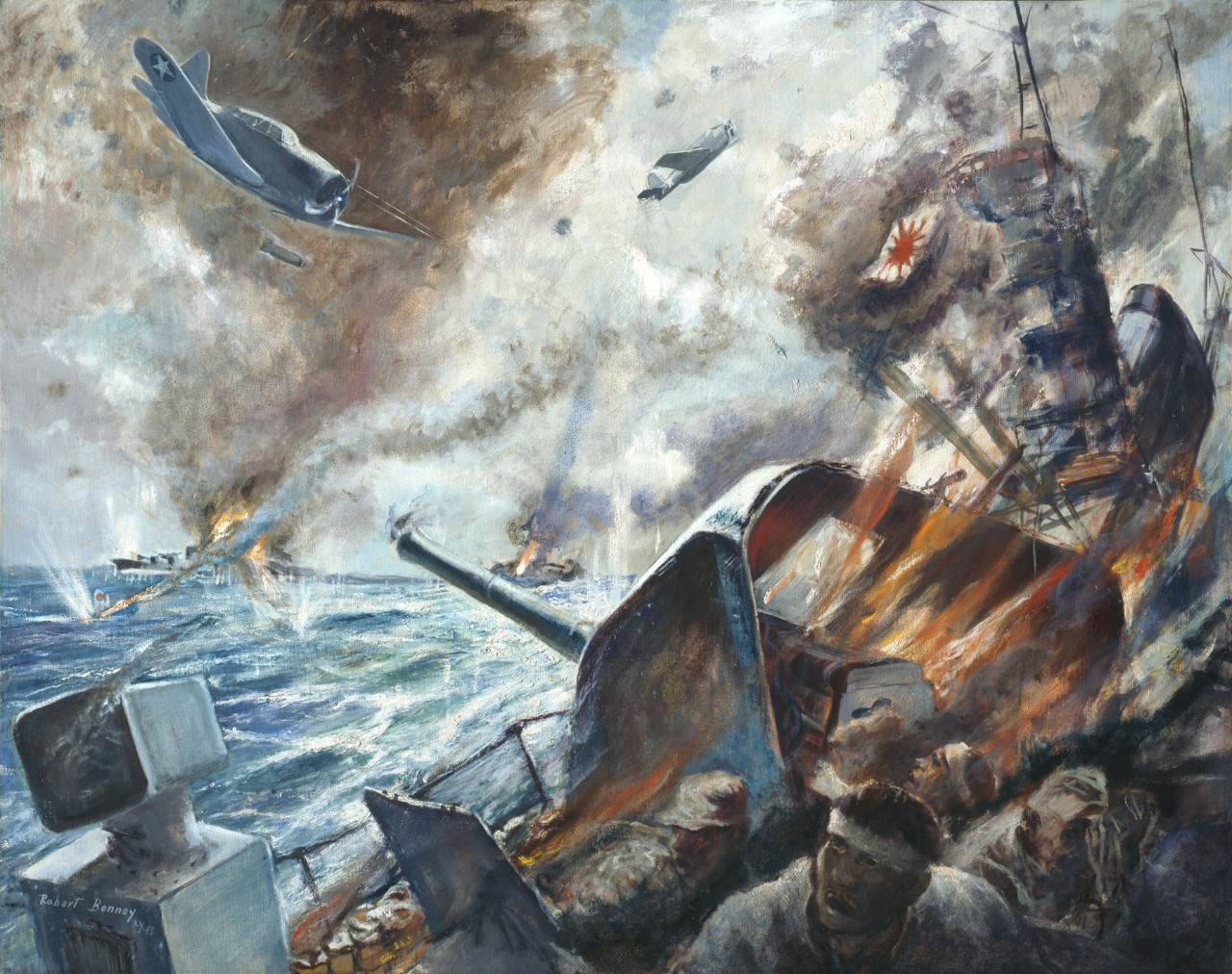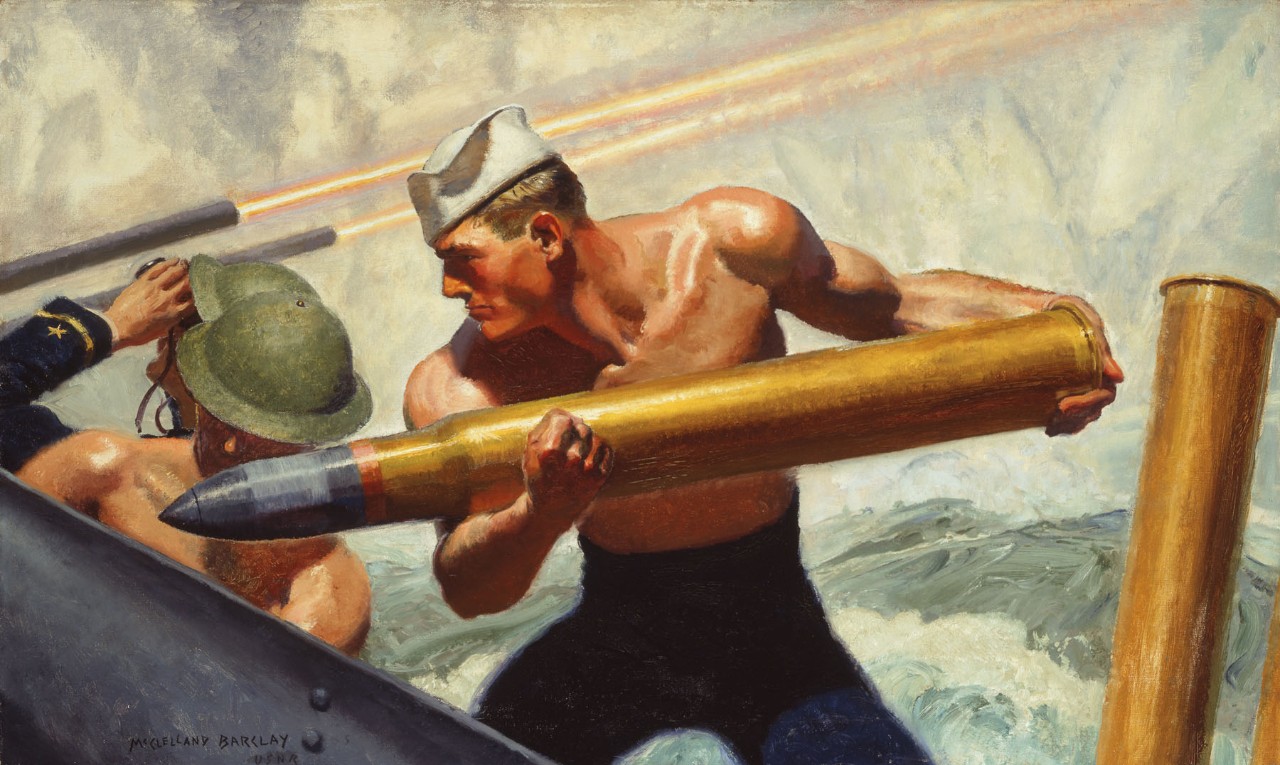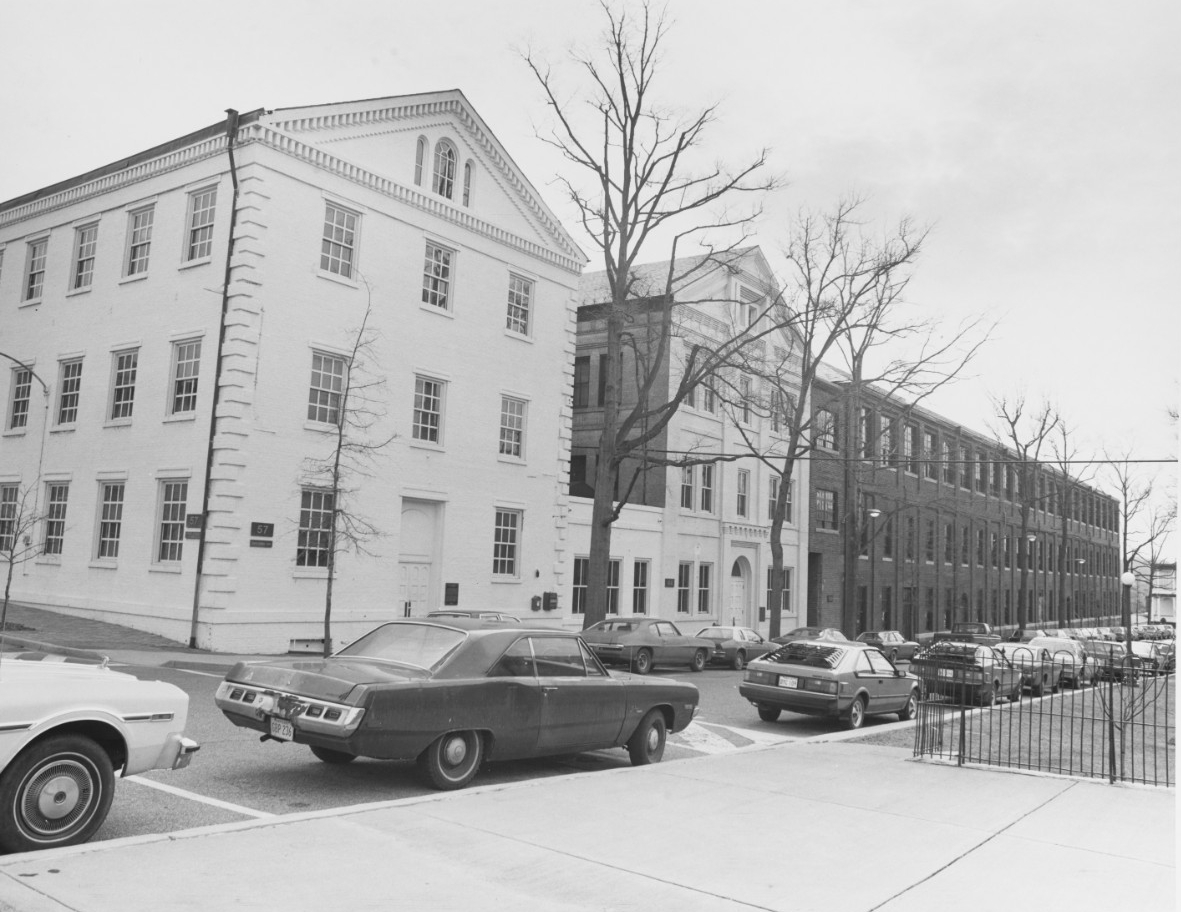Origins of the Naval History and Heritage Command
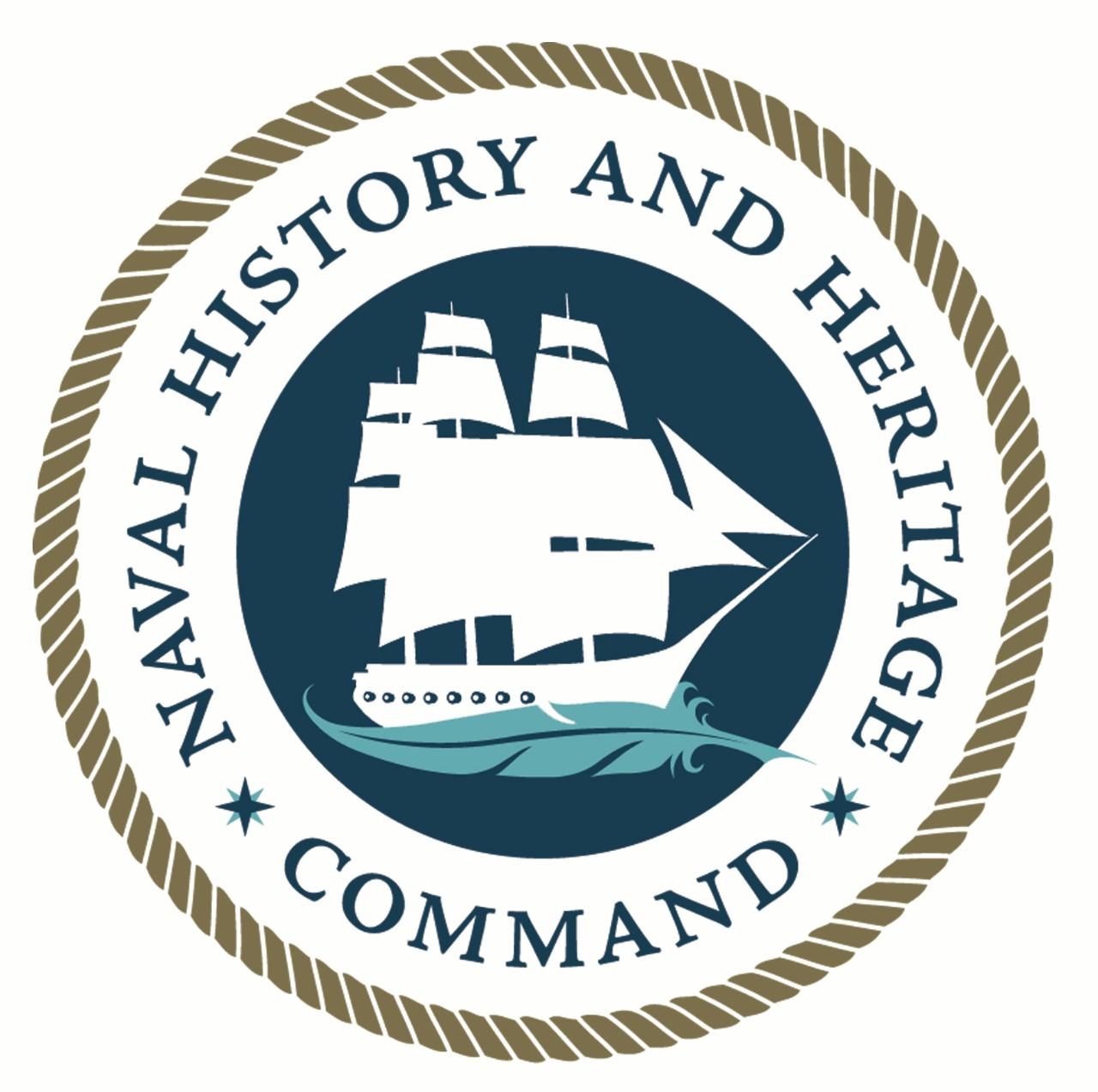
The Naval History and Heritage Command (NHHC) is an Echelon II command headquartered on the Washington Navy Yard, Washington, D.C. As the institutional memory of the U.S. Navy, NHHC’s vision and mission is to ensure the preservation of U.S. Navy history and heritage through its many dedicated historians, librarians, archivists, underwater archaeologists, museum curators, and support personnel. These professionals collect, preserve, and protect the Navy’s important books, documents, art, and artifacts. Others research, analyze, write, and disseminate knowledge products.
NHHC’s roots begin in 1794, when the Navy Department Library was established under the Naval Bureau, which was part of the War Department in Philadelphia. In 1798, the Navy gained its own departmental status, and the Secretary of the Navy was authorized to take possession of all the records, books, and documents relevant to naval matters. This initial collection, subsequently evicted from its Philadelphia quarters by the War Department, found temporary refuge in a tavern in Trenton, New Jersey. When Washington, D.C. became the national capital, the contents of the Navy Department Library were transferred to the Navy’s new home in Georgetown.
In early 1800, President John Adams instructed the first Secretary of the Navy, Benjamin Stoddert, to prepare a catalogue of professional books. President Adams was specific about the type of books he felt were best suited to a naval library.
It ought to consist of all the best writings in Dutch, Spanish, French, and especially the English, upon the theory and practice of naval architecture, navigation, gunnery, hydraulics, hydrostatics, and all branches of mathematics subservient to the profession of the sea. The lives of all the admirals, English, French, Dutch, or any other nation, who have distinguished themselves by the boldness and success of their navigation, or their gallantry and skill in naval combat.
Also in early 1800, Thomas Tingey, the first commandant of the Washington Navy Yard, began collecting naval artifacts and trophies. The first artifact he collected was a French 4-pounder smoothbore gun, cast in 1793 at Lyons, captured during the Quasi-War with France and which is still on the Washington Navy Yard in Leutze Park.
1812–1916
During the War of 1812, the library’s small collection of books and naval records was hidden outside the city and saved from destruction when the invading British set fire to Washington in 1814. Following the war, the Navy Department, including the library, was moved into a two-story brick building located on 17th Street, between F and G streets, later known as the Old Navy Department Building, where it remained until 1879. By 1824, the library catalogue listed 1,349 titles.
In 1865, the Museum of Naval Relics and Weapons opened at the Washington Navy Yard, providing a display building for the collection begun early in the 19th century.
In 1879, the Navy Department Library was relocated to the State, War, and Navy Building (now the Executive Office Building), which was built on the site of the old Navy Department Building. The library was placed under the Bureau of Navigation as part of the Office of Naval Intelligence.
With Public Act No. 21 of 7 August 1882, Congress officially established the library as a departmental institution under Bureau of Navigation, authorized funds for library staff, and combined the library and records section into the Office of Library and Naval War Records. The library gathered rare books, naval prints and photographs, professional periodicals, and naval records. The ornately decorated space occupied by the library, which overlooked the White House and Potomac River, was known as the Indian Treaty Room.
In 1884, Congress appropriated $2,640 to fund the project started by Captain John Grimes Walker that would eventually be published as Official Records of the Union and Confederate Navies in the War of the Rebellion. The project was assumed by Superintendent of the Naval War Records Office, Professor James Russell Soley, who had organized the books, records, prints, and photographs scattered throughout various Navy Department offices under the newly formed Office of Library and Naval War Records. Soley was a naval officer, instructor at the Naval Academy, noted international lawyer, and prolific naval historical writer.
In October 1889, Soley was appointed Assistant Secretary of the Navy, The Office of Library and Naval War Records was placed under the Secretary of the Navy’s office, and Lieutenant Commander Frederick May Wise became the new librarian “In Charge of War Records.”
In 1894, Congress appropriated $15,000 to print Official Records of the Union and Confederate Navies in the War of the Rebellion. The initial volume contained 890 pages, sold for $1.40 a copy, and marked the beginning of a continuing responsibility to collect, edit, and publish significant documents on various periods of U.S. Navy history—a mission that continues today. Five additional volumes would be published between 1895−1897, under the direction of Captain Richard Rush, who succeeded Commander Wise in 1893. The 31-volume series would not be completed until 1927.
In 1904 and 1906, Congress passed legislation providing for the transfer to the Secretary of the Navy of naval records in the custody of executive agencies pertaining to the Navy in the American Revolution, and to the U.S. Navy from its establishment until the Civil War.
In 1908, the Spokane Navy League donated a trophy to the Navy for use as a fleet-wide award for proficiency in gunnery. The Spokane Trophy is catalogued as the first item in what is now the NHHC central artifact collection that currently numbers over a quarter of a million artifacts.
Until 1915, the Office of Library and Naval War Records received separate appropriations for the purchase of technical books, magazines, and other services for the library, and for the collection, duplication, and publication of Official Records of the Union and Confederate Navies in the Civil War. In March 1915, an act of Congress consolidated appropriations under the Office of Naval Records and Library.
1917–1918
In 1917, with the publication of Volume 27, the Office of Naval Records and Library suspended further work on this Civil War records project and shifted its emphasis to matters of contemporary historical importance. During WWI, the library was the mecca for news correspondents and others who utilized its reference facilities for information on treaties, international law, and subjects related to the war. Additionally, naval officers, allied officials, and members of the government were frequent visitors to the library. Secretary of the Navy Josephus Daniels used the library facilities more than any previous Secretary. The reading room was sometimes used for confidential conferences on antisubmarine warfare devices, models of which could be displayed on the library table, or as a lecture hall where such things as escort duties and the convoy system could be explained.
Prior to 1917, the principal function of the Office of Naval Records and Library was to take charge of the Navy Department’s earliest books, manuscripts, historical material and old records, rather than to collect and make current records available for contemporary and future historical or official purpose. World War I, however, transformed the Office of Naval Records and Library from functioning primarily as custodian of books, manuscripts, old official records, and other historical material to a collector of current Navy records.
The idea that such a mission should be undertaken by the Navy seems to have originated as a result of an announcement on 3 June 1918 that the War Department was beginning work on and proposed to “...publish a History of the War of 1917....” In a letter soliciting active cooperation, Secretary Newton B. Baker informed the Secretary of the Navy that the Army tentatively planned to include one volume on naval operations. Instead of appointing a naval officer to serve as liaison with the Historical Branch in the War Department for this purpose, the Navy decided to initiate a similar work and produce a separate publication of naval operations during the war.
On 18 August 1918, the Secretary of the Navy issued a Circular Notice stating that “...a History Section has been established under the direction of the Chief of Operations....” and directed that the collection of historical material be carried on until the end of the war. Recognition of the importance of the historical aspects of naval operations and the growing volume of current war records resulted in the appointment of Rear Admiral W.W. Kimball, USN (Ret.) as head of the new section.
Also in 1918, Admiral William S. Sims, commanding United States Naval Forces Operating in European Waters, was instructed to ascertain what was being done to collect historical data on English, French, and Italian Allied naval operations. He reported that Great Britain had established a staff of experts under its War Cabinet to compile and arrange historical data on naval, military, and air force operations during the war. Admiral Sims proposed an arrangement of reciprocal access between the two countries for the purpose of sharing historical data. Sims created a Historical Section in the staff of the U.S. Naval Forces Operating in European Waters in London, but before it could be fully staffed and operational, the Armistice was declared. Commodore (then Captain) Dudley W. Knox, USN, had been designated head of Admiral Sim’s project with a staff of approximately 20 officers and 50 enlisted men tasked with collecting documents of historical value in connection with naval operations in the war against the Central Powers.
1919–1938
On 1 July 1919, the Secretary of the Navy ordered the Historical Section and the Office of Naval Records and Library be incorporated into the Office of Naval Intelligence under the Director of Naval Intelligence and the Chief of Operations. With this consolidation, the demarcation between “old” and “current” records was recognized and accepted as marking the respective spheres of the original Office of Naval Records and the newer Historical Section. A few years later, as World War I records outgrew their original secret or confidential classifications, this distinction gradually lessened, and the scope of the work of the Office of Naval Records was broadened to include all operational records regardless of the date of origin.
Captain Dudley Knox became head of the Office of Naval Records and Library and the Historical Section in 1921, and oversaw both for 25 years. The two offices merged under Captain Knox in 1927. As part of an attempt to establish a national Navy museum, on 15 April 1930 the Secretary of the Navy asked for an inventory of Navy and Marine Corps monuments and relics at stations across the country. Captain Knox was appointed to coordinate the project as the Curator for the Navy Department on 28 April 1930. (Today, the Director of the Naval History and Heritage Command is the Curator for the Navy.) This attempt to establish a Navy museum was unsuccessful.
In 1921, the Office of Naval Records and Library consisted of the Library, the Old Records Section, and the World War Section. The library was not only the central source of books, magazines, and reference for the administration of the entire Navy Department, but its facilities were frequently utilized by members of Congress and other departments of the government. The Old Records Section, which had formerly been the mere custodian of an unorganized mass of old papers and documents, gradually evolved into the most valuable and principal original source of naval history in the country under the supervision of Commodore Knox. Containing more than million old documents and manuscripts dating from the beginning of the Navy to the late 1880s, these records were frequently consulted by civilians as well as technical historians and researchers. As Curator of the Navy Department, Knox was also made responsible for the collection and preservation of objects, trophies, and relics of historical or inspirational value to the Navy—except those permanently assigned to the Naval Academy and other naval stations—pending construction of a new Navy Department building that would eventually serve as a Navy museum.
Upon publication of the last volume of Official Records of the Union and Confederate Navies in the War of the Rebellion in 1922, Knox focused his resources on the mission to collect, edit, and publish historical naval documents. In 1934, Knox received appropriation from Congress for the printing of seven volumes of Naval Documents, Quasi-War with France, and six volumes of Naval Documents, United States Wars with the Barbary Powers. This same mission continues today with NHHC’s American Revolution and War of 1812 documentary projects.
In the interwar years, Commodore Knox and his staff carried out the stated purpose of the Office of Naval Records and Library to render assistance to any civilian or extra-departmental researchers interested in naval subjects. The office earned a reputation as an accessible public resource on Navy history. On 15 November 1931, the Washington Sunday Star described the Office of Naval Records and Library:
In large, well arranged Library of the Navy Department in the Navy Building are more than 77,572 volumes, records and documents on Navy Science, reference, biographies, and history. Here are Admiral Dewey's original papers and also those of Admiral Farragut and Admiral Porter.... (The Navy Library) also has a file of 35,000 photographs pertaining to ships, personnel and other Navy subjects.... Its most ancient original documents are copies of the instructions given to the Navy Commanders to Capture British boats, signed by Henry Laurens, President Continental Congress, April 3, 1776....
On 1 April 1935, Los Angeles Times columnist, Harry Carr described his experience working with Commodore Knox and his staff: “They gave me a desk in the Bureau of Records, a special library assistant, the use of a stenographer, sent a car for me every morning and dug up so many old log books and records that I lived for two weeks in a lather of excitement....”
Illustrating the rapidly emerging importance of photography in the library’s collection, a 22 November 1931 Washington Post story described “The U.S. Navy’s Family Album” and stated, “If the 70,000 Pictures Comprising the Gallery Tucked Away in Room 3629 of the Navy Building Were Ever Mounted in Albums, a New Building Would Be Needed to House Them. They Embrace History of the Navy and Allied Subjects. . . And Still Serve a Valuable Purpose.”
As its pictorial branch and other facilities became more widely known through the public media, an increased interest in the Navy’s part in the historical development of the nation was reflected in the growing number of requests to the library from the general public. In mid-summer 1939, just before World War II broke out in Europe, the Office of Naval Records and Library had almost completed volumes of early historical documents pertaining to the Quasi-War with France and the naval records of the Barbary Wars, and was looking forward to printing a collection of documents pertaining to naval operations during the War of 1812, and during 1917 and 1918.
General Order No. 32 on 13 May 1935 created policy for the “public exhibit of naval material.” The act of Congress stated that “condemned or obsolete ordnance, guns, projectiles, and other condemned or obsolete material which may not be needed in the service of the Department may be loaned or given to soldiers’ monument associations, posts of the Grand Army of the Republic, posts of the American Legion, and other recognized war veteran associations, State museums, and municipal corporations....” The current NHHC historic weapons collection contains artifacts that date to the 17th century.
The core of the collection was created by Rear Admiral John A. Dahlgren, a former commander of the Washington Navy Yard and a naval ordnance innovator. After being assigned to ordnance duty at the Navy Yard as a lieutenant in 1847, Dahlgren invented and developed bronze boat guns, heavy smoothbore shell guns, and rifled ordnance. Dahlgren formed the first sustained weapons research and development program for the U.S. Navy, which earned him the title “father of American naval ordnance.”
1939–1945
In September 1939, in anticipation of expanded operational activities preceding World War II, the Office of Naval Records and Library was relocated from the Main Navy Building to other branches. In June 1940, Commodore Knox published guidance for operations during a state of emergency.
a. The Library proper will continue to function substantially as at present, giving priority to information for Navy Department use.
b. The Publications Section will stop sending material to the printer, but will complete preparation of typed material of Barbary Wars, for future publication.
c. The World War Section will minimize work not connected with research for the Navy or other Government Departments. It will prepare to move to other quarters and keep in a state of readiness to do this. It will be prepared to archive war diaries and other documents related to the current emergency.
d. The Old Records Section will minimize research work not connected with Navy or other Government Departments. Most outside inquiries can be answered by a circular stating that such work has been suspended until after the emergency. Continue transfer of papers from Bureau of Navigation files, but be prepared to stop it. Organize in readiness for moving to other quarters should the necessity arise.
e. The Picture Section will undertake "to receive, record, classify and distribute as necessary photographs of current or potential strategic or historical interest". The distribution will include appropriate bureaus and offices of the entire Navy Department, as well as outside naval agencies.
At the outbreak of World War II, the Office of Naval Records and Library consisted of the Library, the Publications Section, the Manuscript Section (which was formed from the Old Records Section and the World War I Section), and the Graphics Section (which was organized earlier as the Pictorial Branch). The collections in the Navy Department Library had developed from a few hundred volumes to about 89,484 and 182 periodicals. In addition, there were collections of approximately 40,588 photographs, 1,037 charts and maps, and 5,000 pamphlets. Nearly two million manuscript records, dating from before the organization of the Navy Department in 1798 through World War I, were located in the official archives cared for by this office.
Because space in naval installations was scarce during the war, the Library, branches, and assets were scattered throughout different government buildings. Records in the Manuscript Section dated prior to 1911 were turned over to the custody of the National Archives. Records dated 1911 and later were stored at the National Archives for the duration of the war but remained in the legal custody of the Navy Department. The National Archives agreed to provide space for Knox’s civil service personnel attached to the stored records so there would be no interruption of their work. Most Library volumes were temporarily stored in borrowed stacks in the Library of Congress. The Pictorial Section, whose collection was rapidly changing from historical to strategic photographs, was moved to the Steuart Building under the supervision of the Office of Naval Intelligence.
Although the basic mission remained the same, after Pearl Harbor the Office of Naval Records and Library’s immediate objectives were redirected to the war effort:
a. to procure and commission the most skilled personnel that could be obtained in the field of naval archives and history;
b. to survey the entire field of operational records with a view to determining which, in addition to war diaries, would be most valuable to the war effort;
c. to arrange, classify and disseminate to those authorized to know whatever pertinent operational data were received by the office.
In order to catalog and document the war, additional staff were needed. Selection of key personnel began within a week of 7 December 1941. In 1942, Pulitzer Prize-winning Harvard history professor, Dr. Samuel Eliot Morison, was commissioned as a lieutenant commander in the U.S. Naval Reserve to document the history of World War II “from the inside.” He led a cadre of Sailor-historians in collecting the wartime documentation that would become the foundation of his 15-volume History of the United States Naval Operations in World War II.
Mr. Tracy Barrett Kittredge, who had served as a lieutenant in World War I under Admiral Sims in London, was sworn in as a lieutenant in the U.S. Naval Reserve and took over the systematic collection of war documentation, prepared a plan for further staffing, and suggested the extensive use of microfilm as a solution to the limited space problem. Additional staff came from the academic and research fields related to naval or maritime history.
To carry out its mission of classification and collection of manuscript materials pertaining to the conduct of the naval side of the war, The Old Records Section developed relationships with other Navy branches, including the Readiness Section, the Combat Narratives Branch, and the Office of Records Administration. As an adjunct to developing the World War II operational archives, Commodore Knox’s staff pioneered an oral history program whereby participants in the Pacific and Atlantic were interviewed as soon as possible after significant operations and battles. Recorded narratives had proven to be an asset in World War I, but only if the narrative could be secured immediately after the action had taken place.
One of the duties of the Office of Naval Records and Library in the pre-war mobilization plan was a letter of instruction to cover the preparation of war diaries in the event of war. On 29 April 1941, Commodore Knox sent a memorandum to the Director of Naval Intelligence with a draft of the proposed letter, which was to be sent out in the event of mobilization. This letter was submitted in December 1941 and was immediately met with opposition from various offices in naval operations. The letter of instructions was subsequently rewritten and was issued on 22 February 1942, signed by the Chief of Naval Operations. Prior to the directive, certain ships and task forces, particularly in the Pacific, had been keeping war diaries on their own initiative, which when submitted proved to be of very considerable value. As the war diaries began to be received in Washington, the attitude toward them changed almost immediately, and their high value as a source of current operational information and guidance was quickly recognized.
However, the Vice Chief of Naval Operations, in a 4 February 1943 memo to Commodore Knox, stated, “In view of the desire of our Commanders in the theaters of operations to remain unhampered, insofar as possible, by persons or activities not essential to the business of fighting, I regret that I cannot permit sending personnel into the field for the purposes specified in your memorandum dated January 29, 1943, in which you requested the services of Ship’s Clerk Richman."
The recorded narrative project was approved a few months later on 1 May 1943, but was limited in scope to the Pacific Fleet with two recordgraphs and operating personnel, with the understanding that one recordgraph would be used at Pearl Harbor and another at the discretion of Commander Third Fleet. All recordings had to be sent to Commander in Chief U.S. Fleet for review. Although the fundamental aspects of the project remained intact, the scope and range had been significantly scaled back.
The Navy Combat Art Program was founded in 1941 through the persistence of Griffith Baily Coale, a well-known muralist, as a way to send artists into the field to document naval history in action. One of these artists, McClelland Barclay started his naval art career in 1917 when he was awarded the Navy Poster Prize for his design, “Fill the Breech.” In 1938 he was appointed Assistant Naval Constructor with the rank of lieutenant in the Naval Reserve. In 1940, he reported for active duty. He designed Navy recruitment posters for two years in the New York Recruiting Office, and when the United States entered World War II, he volunteered to become a combat artist. He was not accepted into the program, but he continued to fulfill a similar function through the recruiting office. Barclay sought opportunities to follow and document the fleet, and was able to go to sea in both the Atlantic and the Pacific. On July 18, 1943 he was embarked in the landing ship LST 342 in the Pacific Ocean when the ship was torpedoed and sunk by a Japanese submarine. Barclay was lost along with most of the crew, and became (to our knowledge) the only person to die in action pursuing a historical discipline now found at NHHC.
The Navy Combat Art program was revived in the Korean War and in the Vietnam era, and today is carried on by two civilian artists attached to NHHC. The Combat Art Collection was combined with art in the custody of the Director of Naval History in 1986 to form the Navy Art Collection (OPNAVINST 5754.1D, Loan of Navy Art). Today, the NHHC Art Collection’s over 20,000 paintings, prints, drawings, sculptures, and engravings includes artwork collected by the Library that dates to the early 19th century; original artwork by McClelland Barclay and other Navy artists; artwork from the Combat Art Program from World War II, the Korean War, the Vietnam War, Desert Shield/Storm, and Operation Iraqi Freedom/Enduring Freedom; an extensive collection of art and artifacts donated by the Naval Historical Society in the late 1990s; and artwork collected by the library that dates to the early 19th century.
1946–Present
After World War II, the Library slowly recovered from its wartime dispersal. In 1944, Secretary of the Navy James Forrestal had established the Office of Naval History to prepare histories and narratives of naval activities of World War II. Admiral Edward C. Kalbfus was appointed Director of Naval History. Although established as a separate office from the Office of Naval Records and Library, Captain Knox served as Admiral Kalbfus’ deputy director as an additional duty. The duties of Curator for the Navy were assigned to the Chief of Naval Operations in 1945, although still exercised by the Director of Naval History, thus laying the groundwork for an independent Marine Corps program. The Office of Naval History merged with the Office of Naval Records and Navy Library in 1949 to the form the Naval Records and History Division in the Office of the Chief of Naval Operations. The name was shortened to the Naval History Division in 1952. Commodore Knox, together with his expanded wartime staff and manuscript material, augmented by accessions of air and submarine patrol reports, war diaries, action reports, and operation plans and orders, moved back to the Navy Building in 1945. Less than a month after the move, the contents of the Navy’s Microfilm Library, as well as its space, equipment, and personnel, were assumed by the Office of Naval Records and Library.
The next home for the Naval History Division would be the Washington Navy Yard, where NHHC still resides. In 1961, the three-decade effort to establish a Navy museum in Washington bore fruit when Chief of Naval Operations Admiral Arleigh Burke established the U.S. Naval Historical Display Center in Building 76). Operational Archives moved to the Navy Yard in 1963, and by 1970 all other sections followed, although they were dispersed throughout multiple buildings throughout the Navy Yard.
In 1971 the Naval History Division was merged with the Naval Historical Display Center (now the National Museum of the US Navy) to create the Naval Historical Center. In 1982, the Naval Historical Center moved into a new building complex named in honor of Commodore Dudley W. Knox. Also in 1982, the Naval Historical Foundation donated its collection of art and artifacts to The Navy Museum.
In 1991, following the disestablishment of the Supervisor of Shipbuilding Boston, oversight of the USS Constitution Maintenance and Repair Division was transferred to the Naval Historical Center. The origins of what is now known as NHHC’s Detachment Boston can be traced to September 1897, when USS Constitution returned to Boston in time for the 100th anniversary of her 21 October 1797, launch. From the 1906–1907 restoration of the ship after her arrival in Boston through to the closure of the Charlestown Navy Yard in 1974, hundreds of shipyard workers helped to maintain, rebuild, restore, and research Constitution. In 1954, Public Law 523 authorized the Secretary of the Navy “to repair, equip, and restore the United States ship Constitution as far as may be practicable, to her original condition, but not for active service, and thereafter to maintain the United States ship Constitution at Boston, Massachusetts.”
As a result of lessons learned from the first Gulf War, Naval Reserve Combat Documentation Detachment 206 was established in 1991 to deploy documentation teams to U.S. Navy, joint, and combined commands worldwide to conduct oral history interviews, collect historically significant artifacts and records, and document operations through photography and art. The collection effort contributes to the Navy’s lessons learned and preserves the history of current naval operations during crisis response, wartime, declared national emergency, or in situations as directed. The detachment was renamed Navy Combat Documentation Unit in 2018.
In 1996, the Underwater Archeology Branch was established for the protection and study of submerged cultural resources under Navy management. Today, a primary responsibility of the branch is the protection of sunken military craft owned by the United States from unauthorized disturbance under the Sunken Military Craft Act enacted in 2004. The branch also maintains a collection of archaeological artifacts associated with sunken military craft.
In 2006, the Naval Historical Center was given oversight of all SECNAV-designated Navy museums, which before then had been under the supervision of their sponsoring warfare communities or regional commands. In 2008, the Naval Historical Center was renamed the Naval History and Heritage Command in recognition of its broader responsibilities.
In 2015, NHHC’s central artifact collection was consolidated from several locations into a newly-established Collection Management Facility (CMF) at the Defense Supply Center in Richmond, Virginia. Curators and conservators at the CMF, which is not open to the public, manage the storage, conservation, and loan of NHHC’s central artifact collection. The NHHC Conservation Branch, also established in 2015, uses laboratory facilities at the CMF to conserve artifacts from the central and museum collections, as well as providing advice and assistance on artifact protection and conservation to a variety of official customers.
Today, the Naval History and Heritage Command’s operations fall into four divisions:
The NHHC Collection Management Division (CMD) is concerned with the stewardship and interpretation of Navy material culture, using art and artifacts to tell of the Navy’s history on line, through the Navy museums, and through a robust loan program to museums and other eligible institutions worldwide. The Art Branch manages the Navy Art Collection, including loans and the creation of new works through the combat art program. The Curator Branch manages the central artifact collection of more than 300,000 objects reflecting the operational, technological and social history of the Navy. The Conservation Branch applies highly sophisticated conservation techniques to document and conserve objects in both the central collection and in the Navy museums. The Underwater Archaeology Branch manages the Navy’s sunken military craft ─ more than 3000 shipwrecks and 14,000 aircraft wrecks ─ and administers a permitting program for certain operations affecting sunken military craft, analyzes and interprets information from archeological investigations, and conserves and lends archaeological artifacts.
The NHHC Histories and Archives Division (HAD) includes Navy historians and researchers, the Navy Department Library, and the Navy photography collection. HAD houses nearly 11,000 reels of microfilm, six terabyte of electronic data, and over 200 million pages of documentary history. HAD’s Archives Branch manages reams of documents that include deck logs, organizational records, and command operations reports, photo archives, ship and aviation unit records, and the branch also manages Freedom of Information Act requests. The Navy Department Library collection contains over 182,000 books and 374,000 manuscripts.
The NHHC Museum Operations Division (MOD) is responsible for the oversight and administrative requirements for the ten Navy museums. MOD staff works with each facility to attain or maintain American Alliance of Museums accreditation and develop the NHHC properties into a “Smithsonian-class” network of museums.
The NHHC Communication and Outreach Division (COD), established in 2013, maintains the command website and blog, as well as NHHC’s social media presence; oversees the publication of books, essays, and pamphlets on naval history; and is the public face of NHHC at official Navy events. In 1999, in NAVADMIN 164/99, CNO specifically designated the anniversary of the Battle of Midway and the Navy’s birthday on 13 October as notable commemorative annual events in the Navy. COD is responsible for ensuring resources, information, history, communication material, and onsite support are available for these events, as well as other notable naval anniversaries, celebrations, and commemorations.
For more information on the History of the Naval History and Heritage Command, please explore the links below:
- A History of the Dudley Knox Center for Naval History
- History of the Navy Department Library: A Bibliography
- History of the Navy Department Library
- Preserving an Honored Past
- Historical Sketch of the Navy Department Library and War Records
- U.S. Navy Libraries: Historic Documents
- Survival of the Collection of the Navy Department Library
- Our Vanishing History and Traditions
- Office of Naval Records and Library 1882-1946

